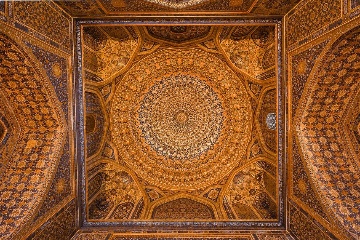The Bibi Khanym Mosque in Samarkand, Uzbekistan, is one of the most remarkable examples of Islamic architecture from the Timurid period. Built between 1399 and 1404 by the order of the great Turco-Mongol conqueror Timur, this massive mosque complex was intended to be the centerpiece of his capital city and a testament to his power and wealth. The mosque was named in honor of Timur's senior wife, Saray Mulk Khanym, though legends often refer to it as Bibi Khanym Mosque.

The mosque's design reflects the influence of Persian and Central Asian architectural traditions. It features a massive rectangular courtyard measuring 167 meters long and 109 meters wide, surrounded by four grand iwans (vaulted recesses) and numerous smaller chambers, including a madrasa (religious school). The main prayer hall, located at the western end, is topped by a soaring tiled dome over 40 meters high, flanked by two minarets reaching more than 50 meters in height.
The mosque's exterior and interior were lavishly decorated with glazed ceramic tiles in shades of blue, turquoise, and white, forming intricate geometric patterns and Arabic calligraphy that showcased verses from the Quran. These decorations were meant to inspire awe and symbolize the grandeur of Timur's empire.
Despite its magnificence, the mosque suffered significant damage over the centuries due to earthquakes and neglect. By the late 19th century, much of the complex had fallen into ruins. However, extensive restoration efforts in the late 20th century have revived parts of the structure, allowing visitors to appreciate its historical and architectural significance.
The Bibi Khanym Mosque remains an iconic landmark in Samarkand and a UNESCO World Heritage Site. Its scale, design, and decorative elements continue to inspire admiration and serve as a testament to the artistic and architectural achievements of the Timurid era.




































